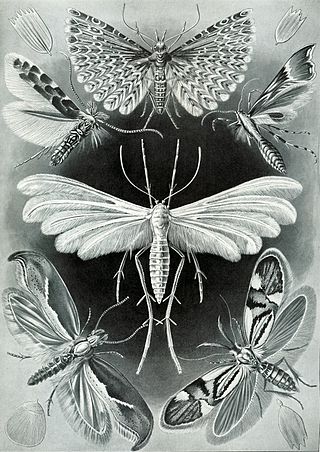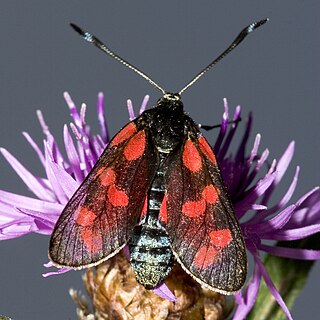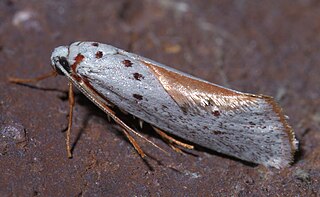
The Zygaenidae moths are a family of Lepidoptera. The majority of zygaenids are tropical, but they are nevertheless quite well represented in temperate regions. Some of the 1000 or so species are commonly known as burnet or forester moths, often qualified by the number of spots, although other families also have 'foresters'. They are also sometimes called smoky moths.

Microlepidoptera (micromoths) is an artificial grouping of moth families, commonly known as the "smaller moths". These generally have wingspans of under 20 mm, so are harder to identify by external phenotypic markings than macrolepidoptera. They present some lifestyles that the larger Lepidoptera do not have, but this is not an identifying mark. Some hobbyists further divide this group into separate groups, such as leaf miners or rollers, stem or root borers, and then usually follow the more rigorous scientific taxonomy of lepidopterans. Efforts to stabilize the term have usually proven inadequate.

The Zygaenoidea comprise the superfamily of moths that includes burnet moths, forester moths, and relatives.

Cossoidea is the superfamily of moths that includes carpenter moths and relatives. Like their likely sister group Sesioidea they are internal feeders and have spiny pupae with moveable segments to allow them to extrude out of their exit holes in stems and trunks during emergence of the adult.

The Limacodidae or Eucleidae are a family of moths in the superfamily Zygaenoidea or the Cossoidea; the placement is in dispute. They are often called slug moths because their caterpillars bear a distinct resemblance to slugs. They are also called cup moths because of the shape of their cocoons.

The Himantopteridae are a family of moths in the superfamily Zygaenoidea. The family is alternatively included in the family Anomoeotidae as a synonym.

The Somabrachyidae are a family of moths in the order Lepidoptera. Other than Somabrachys aegrota, which also occurs in Spain and on Sicily, the family is Afrotropical.

The insect order Lepidoptera consists of moths, most of which are night-flying, and a derived group, mainly day-flying, called butterflies. Within Lepidoptera as a whole, the groups listed below before Glossata contain a few basal families accounting for less than 200 species; the bulk of Lepidoptera are in the Glossata. Similarly, within the Glossata, there are a few basal groups listed first, with the bulk of species in the Heteroneura. Basal groups within Heteroneura cannot be defined with as much confidence, as there are still some disputes concerning the proper relations among these groups. At the family level, however, most groups are well defined, and the families are commonly used by hobbyists and scientists alike.

Parasa is a genus of moths of the family Limacodidae. It was described by Frederic Moore in 1860.
Austrapoda is a genus of moths of the family Limacodidae.
Austrapoda beijingensis is a species of moth of the family Limacodidae. It is found in China.
Lactura pyronympha is a moth of the family Lacturidae. It was described by Edward Meyrick in 1923. It is found in Papua New Guinea, where it is a common and widely distributed species.
Lactura pyrilampis is a moth of the family Lacturidae. It was described by Edward Meyrick in 1886. It is found on New Guinea and Papua New Guinea.

Lactura is a genus of moths in the family Lacturidae.
Gymnogramma hollandi is a moth of the Lacturidae family. It is only known from the Republic of the Congo.

Lactura basistriga is a species of tropical burnet moth in the family Lacturidae. It was first described by William Barnes in 1913.

Chrysopolominae is a subfamily of moths in the family Limacodidae. The type genus of this subfamily is Chrysopoloma. Chrysopolominae was originally a family (Chrysopolomidae) under the superfamily Zygaenoidea, consisting of two subfamilies, including about 30 species distributed in Africa, but in other newer documents, this family was downgraded and became It is a subfamily under Limacodidae, which belongs to the superfamily of Zygaenoidea, and the two subfamilies originally under Chrysopolominae were merged to become the synonym of Chrysopolominae called Ectropinae.












